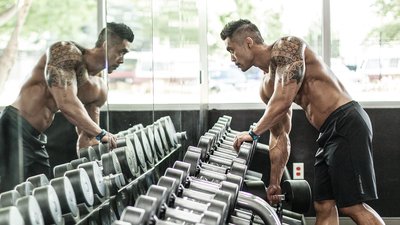Nothing beats setting PRs in the gym. Whether it's the first time you benched 225 pounds for a single rep or squatted 315 for 10, these big, round numbers matter. Each is a milestone you must conquer before reaching your next one.
Comfortably lifting a weight that was once out of reach shows you how your body can adapt to overloads you place upon it. But reaching the next level of strength and size requires you to continue increasing the demands on your body, a concept known as progressive overload, which is a basic tenet of resistance training.
If your goal is to build muscle size, what is the most effective way to make additional gains? You have two principal approaches to choose from: more weight, or more reps. Adding more weight or doing additional reps will both increase the overload, but if you're training for maximum muscle size, doing singles isn't the best method. Powerlifters commonly build their programs around sets of threes and fives, because using maximum loads for just one rep is a measure of strength, not the best way to build it. This is also why singles aren't a part of traditional bodybuilding programming.
More commonly, people pursuing maximal increases in muscle size train in the 8- to 12-rep range. So instead of focusing on your 1RM, let's instead focus on lifting for a higher rep count.
Your 8RM Is the Moneymaker
Use the "2 for 2" rule when deciding if it's time to increase the amount of weight you're lifting: When you can do two more reps with a given weight than you started out with for two consecutive workouts, increase the weight.
Say, for example, you can do 225 for a single rep on the bench press, and 185 pounds on the bench press for a clean set of 8 reps. With time and the right approach to training, you'll ultimately be able to achieve 185 for 10 reps. When you do that for two chest workouts consecutively, that's your cue to increase the load. Alternatively, you could increase the weight when you can do your 10RM for 12 reps.

But how much more weight should you put on the bar? Here's a tried-and-true approach:
When doing upper-body exercises, increase the load by about 5 percent. So, instead of your working weight being 185 on the bench, it now becomes about 195. Of course, expect your reps to drop, but that only means you start the process over again, training to increase your strength back up to 10 reps.
With lower-body exercises in which you're typically stronger, increase the load by about 10 percent. So, if you've been squatting 275 for 8 reps and can finally achieve 10 reps for two workouts in a row, your new top weight becomes 275 plus 27.5, or about 300-305. That may seem like a big jump, but if your 10 reps with 275 were legit reps—clean, smooth, no nosebleeds or passing out—you can handle it.
Of course, this approach won't last indefinitely. You'll still encounter training plateaus along the way. When that happens, you will have to get more creative and use more advanced training principles. But for building your base, there's no substitute for having reasonable expectations, setting achievable goals, and getting in your reps.

